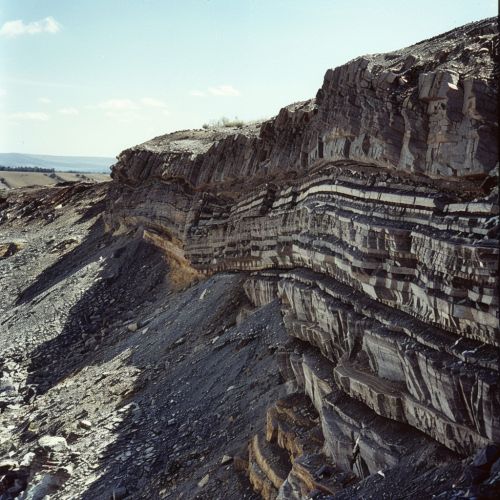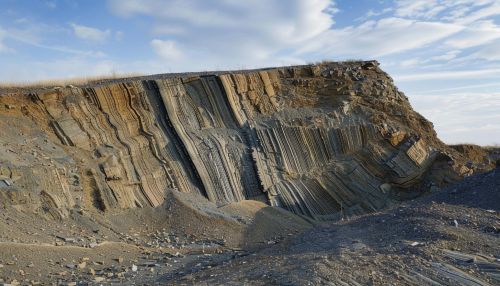Monocline: Difference between revisions
(Created page with "== Introduction == A '''monocline''' is a simple bend in the rock layers so that they are no longer horizontal. It is a type of geologic fold that is characterized by a steep dip in one direction, causing the rock strata to incline from the horizontal. Monoclines may be small features of only a few meters in size or they can extend for several kilometers, forming prominent landscape features. == Formation == Monoclines are formed by differential comp...") |
No edit summary |
||
| Line 35: | Line 35: | ||
* [[Foreland basin]] | * [[Foreland basin]] | ||
[[Image:Detail-77631.jpg|thumb|center|A photograph of a prominent monocline, showing a steep dip in the rock layers.|class=only_on_mobile]] | |||
[[Image:Detail-77632.jpg|thumb|center|A photograph of a prominent monocline, showing a steep dip in the rock layers.|class=only_on_desktop]] | |||
[[Category:Geology]] | [[Category:Geology]] | ||
[[Category:Structural geology]] | [[Category:Structural geology]] | ||
[[Category:Tectonics]] | [[Category:Tectonics]] | ||
Latest revision as of 19:43, 6 May 2024
Introduction
A monocline is a simple bend in the rock layers so that they are no longer horizontal. It is a type of geologic fold that is characterized by a steep dip in one direction, causing the rock strata to incline from the horizontal. Monoclines may be small features of only a few meters in size or they can extend for several kilometers, forming prominent landscape features.
Formation
Monoclines are formed by differential compaction over an underlying structure, particularly a large fault at the edge of a basin due to horizontal shortening or horizontal extension. They can also be the result of a combination of mechanical deformation and chemical compaction. The process of formation involves the bending of rock layers due to stress in the Earth's crust.
Types of Monoclines
There are two main types of monoclines: those formed by extensional forces and those formed by compressional forces.
Extensional Monoclines
Extensional monoclines are created when the crust is stretched and thinned, causing the rock layers to sag and form a monocline. This type of monocline is often associated with the formation of rifting and basin and range provinces.
Compressional Monoclines
Compressional monoclines occur when the crust is squeezed and shortened, causing the rock layers to buckle and form a monocline. This type of monocline is often associated with the formation of fold and thrust belts and foreland basins.
Examples of Monoclines
There are numerous examples of monoclines around the world, some of which are prominent landscape features.
Waterpocket Fold
The Waterpocket Fold is a classic example of a monocline. It is located in Capitol Reef National Park in Utah, USA. The fold extends for over 100 miles and is characterized by a sharp bend in the rock layers, causing them to incline from the horizontal.
Grandview-Phantom Monocline
The Grandview-Phantom Monocline is another example of a monocline. It is located in the Grand Canyon in Arizona, USA. The monocline is visible as a steep dip in the rock layers on the North Rim of the Grand Canyon.
Purbeck Monocline
The Purbeck Monocline is a well-known monocline in Dorset, England. It is a prominent feature of the Jurassic Coast, a World Heritage Site. The monocline is visible as a steep dip in the rock layers along the coast.
See Also
- Geological fold
- Extensional tectonics
- Compressional tectonics
- Rift valley
- Basin and Range Province
- Fold and thrust belt
- Foreland basin


